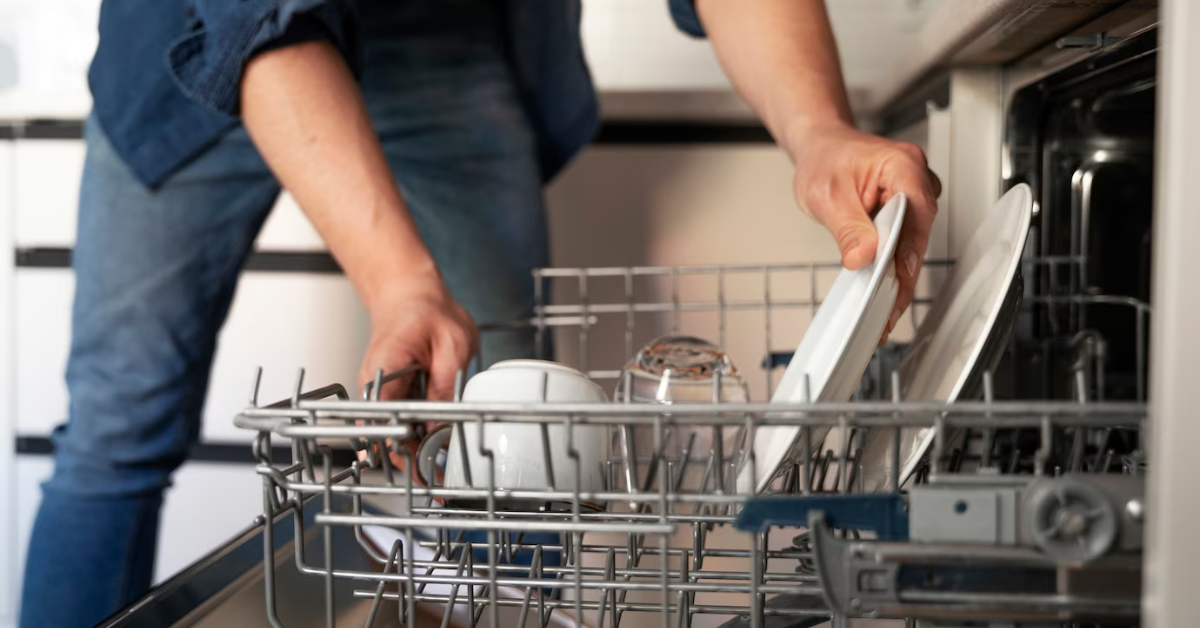Cleaning Stainless Steel Dishwasher Doors: Keep Them Shiny and Spotless
Stainless steel dishwasher doors can elevate the look of your kitchen, but they also require regular cleaning to maintain their sleek, shiny finish. From fingerprints and splatters to water spots, these surfaces can quickly lose their luster without proper care. For residents in Minneapolis, regular maintenance is key, and if you need help, MaidXChange’s house cleaning services in Minneapolis can handle this and more, ensuring your appliances stay spotless and your kitchen gleams. Here’s how to clean your stainless steel dishwasher doors effectively while preserving their appearance
What You’ll Need
To clean your stainless steel dishwasher doors, you’ll need the following items:
- Microfiber cloth: Essential for avoiding scratches and streaks.
- Mild dish soap: A gentle cleaner for removing splatters and grime.
- Stainless steel cleaning spray: Such as affresh® or other specialized products for polishing.
- Rubber gloves: To protect your hands during cleaning.
- Soft sponge or non-abrasive pad: For tougher spots.
- White vinegar or baking soda (optional): For natural cleaning alternatives.
- Paper towels: Handy for drying the rubber gasket and edges.
Step-by-Step Guide to Cleaning Stainless Steel Dishwasher Doors
1. Identify the Grain of the Metal
Just like wood, stainless steel has a grain. Look closely, and you’ll see fine lines running in one direction. Always clean and polish with the grain to avoid streaks and maintain the finish.
2. Remove Surface Dirt and Splashes
- Use a soft sponge or microfiber cloth dampened with warm water and a drop of mild dish soap to gently wipe away splatters and grime.
- Focus on high-touch areas like the handle, where fingerprints accumulate most.
3. Clean the Rubber Gasket
The rubber gasket around the dishwasher door often traps moisture and food particles, leading to stains or odors. Remove it (if possible) or wipe it thoroughly with a damp microfiber cloth and mild soap. Use paper towels to dry underneath the gasket.
4. Polish the Stainless Steel Finish
- Spray a small amount of stainless steel cleaning product, such as affresh®, directly onto a clean microfiber cloth.
- Wipe the surface with the grain of the metal to remove fingerprints, water spots, and smudges, leaving a polished shine.
5. Address Tough Spots
For stubborn grime or discoloration:
- Create a paste using baking soda and water, apply it to the area, and gently scrub with a soft sponge.
- Alternatively, dampen a cloth with white vinegar and rub the spot. Vinegar effectively dissolves mineral deposits and water spots.
6. Dry and Buff
After cleaning, use a dry microfiber cloth to buff the surface. This step ensures a streak-free shine and removes any leftover residue from the cleaner.
Preventing Future Smudges and Stains
- Regular Wiping: Wipe the door weekly with a microfiber cloth and warm water to prevent build-up.
- Avoid Abrasive Cleaners: Never use harsh chemicals or abrasive pads, as they can damage the stainless steel finish.
- Dry Immediately: Water spots form easily on stainless steel, so always dry the surface after cleaning.
- Use a Dishwasher Cleaning Schedule: Incorporate stainless steel door cleaning into your routine dishwasher maintenance to keep it spotless inside and out.
Why the Right Products Matter
Specialized products like affresh® stainless steel cleaning spray are designed to polish without leaving streaks or damaging the finish. Paired with tools like a microfiber cloth, they help maintain the sleek appearance of your dishwasher’s exterior.
For a natural approach, pantry staples like white vinegar and baking soda can effectively clean and deodorize without harsh chemicals.
Don’t Forget the Interior
While the focus is on the dishwasher door, remember that stainless steel interiors also need care. Wipe down the inside of the door and any visible surfaces with a soft cloth and mild soap to prevent grime from building up.
Cleaning the Dishwasher Filter: A Key to Optimal Performance
The dishwasher filter is one of the most overlooked components of your dishwasher, yet it plays a vital role in maintaining its performance. A dirty or clogged filter can lead to poor cleaning results, unpleasant odors, and even damage to the appliance over time. Here’s how to properly clean your dishwasher filter and keep your dishwasher running efficiently.
Why Clean Your Dishwasher Filter?
The dishwasher filter traps food waste, grease, and debris during the cleaning cycle, preventing these particles from clogging the drain or damaging the spraying arms. Over time, this buildup can reduce the appliance’s effectiveness, causing lingering odors and leaving dishes less clean.
What You’ll Need
To clean your dishwasher filter effectively, gather the following items:
- Dishwashing liquid: Gentle soap for cleaning the filter.
- Cleaning brush: A soft-bristled brush or old toothbrush for scrubbing.
- Toothpick: Useful for cleaning cracks and crevices.
- Microfiber cloth: For wiping the area clean.
- Paper towels: To absorb water and catch loosened debris.
- Warm water: For rinsing the filter and components.
Step-by-Step Guide to Cleaning Your Dishwasher Filter
1. Locate the Filter
Most dishwashers have a filter located at the bottom of the appliance, under the lower rack. Check your dishwasher’s manual if you’re unsure where to find it.
2. Remove the Filter
- Gently twist and lift the strainer or filter assembly out of the dishwasher.
- If the filter is secured with clips, release them carefully to avoid breaking the mechanism.
3. Clean the Filter
- Rinse the filter under warm water to loosen any debris or food waste.
- Apply a small amount of dishwashing liquid and use a cleaning brush or old toothbrush to scrub away grease, grime, and buildup.
- Use a toothpick to remove stubborn particles stuck in cracks and crevices.
4. Inspect and Clean the Filter Housing
- With the filter removed, inspect the area for additional debris. Pay close attention to the drain and spraying arms, as food particles often accumulate here.
- Wipe the housing with a microfiber cloth to remove grease and ensure a smooth reinstallation.
5. Reinstall the Filter
- Once the filter is clean, return it to its original position. Make sure it is securely locked in place to avoid damage during future cleaning cycles.
Tips for Maintaining a Clean Dishwasher Filter
- Clean Monthly: Regularly clean the filter to prevent buildup that could affect your dishwasher’s performance.
- Scrape Dishes Before Loading: Remove large food particles from dishes before placing them in the dishwasher to reduce strain on the filter.
- Inspect for Damage: Check the filter and strainer for any cracks or wear and replace them if necessary.
What Happens If You Don’t Clean the Filter?
A neglected filter can lead to several problems:
- Clogs: A dirty filter allows debris to accumulate in the dishwasher’s drain and spraying arms, reducing water flow and cleaning power.
- Odors: Trapped food waste can rot over time, leaving your dishwasher with unpleasant smells.
- Poor Cleaning Results: Grease and grime can re-deposit on your dishes, leaving them less clean than desired.
Natural Cleaning Alternatives
If you prefer eco-friendly methods:
- Use a mixture of baking soda and dishwashing liquid to clean the filter gently.
- Rinse with white vinegar to deodorize and disinfect.
Final Step: Air Dry
Once the filter is clean and reinstalled, leave the dishwasher door open to air dry. This prevents moisture from lingering in the appliance, which could lead to mold or mildew.
Deep Cleaning Techniques for Dishwashers
Over time, dishwashers accumulate mineral build-up, food particles, and residue that can reduce efficiency and lead to unpleasant odors. Regular deep cleaning not only ensures sparkling dishes but also prolongs the life of your appliance. Below are some tried-and-true techniques, including the use of citric acid and lemon juice, that target even the toughest crevices.
1. Why Deep Cleaning Is Essential
- Hard Water Build-Up: If you live in an area with hard water, mineral deposits can quickly accumulate, leading to clogged sprayers and streaky dishes. Perform a deep clean every 3 months—or more frequently in areas with hard water.
- Food Particles in Crevices: Food debris can settle in tight corners and along door seals, creating odors and mold over time. Detailed cleaning of these areas ensures better hygiene.
2. Using Citric Acid for Mineral Build-Up
Citric acid, derived from fruits like lemons, is a powerful yet natural cleaner that dissolves mineral deposits and grease. Here’s how to use it effectively:
- Prepare the Dishwasher: Empty the dishwasher and remove any large debris from the drain or filters.
- Add Citric Acid: Place half a cup of crystallized citric acid in the bottom of the dishwasher.
- Run a Hot Cycle: Use the hottest setting for optimal results. The citric acid will break down mineral build-up and sanitize the interior.
3. Cleaning with Lemon Juice
Lemon juice offers a simple and natural alternative to store-bought cleaners. It’s especially effective for eliminating odors while cutting through grease.
- Top Rack Placement: Pour a cup of lemon juice into a dishwasher-safe container and place it on the top rack.
- Run a Hot Cycle: The steam and heat will distribute the juice, leaving your dishwasher smelling fresh and residue-free.
4. Detailed Cleaning for Hard-to-Reach Areas
For thorough maintenance, pay attention to the crevices and smaller components:
- Sprayer Arms: Use a toothpick or fine brush to clear out food particles clogging the sprayer holes.
- Door Seals: Wipe down the rubber gaskets with a cloth dipped in lemon juice or vinegar to remove grime.
- Racks and Trays: Remove and soak in warm, soapy water if needed.
5. Regular Maintenance Tips
- Monthly Maintenance: Run an empty hot cycle with a cleaning agent like citric acid or vinegar to keep mineral build-up at bay.
- Quarterly Deep Cleans: Use the techniques above every 3-4 months to maintain peak performance.
- Inspect Filters and Drains: Clean these components regularly to prevent clogs.
Why Deep Cleaning Matters
Whether you’re battling hard water stains or lingering food particles, investing time in regular deep cleaning ensures your dishwasher performs efficiently. Citric acid and lemon juice are safe, effective, and easy-to-use tools that tackle everything from grease to mineral deposits.
Ready to give your dishwasher the TLC it deserves? Start deep cleaning today for spotless dishes and a fresher kitchen!



